Rani ki Vav is one the architectural marvels which have got a prominent place not only in the history and architectural books but also on 100 rupees note of India. Rani ki Vav is located in Patan in Gujarat and until you see Rani ki Vav in real life it would be extremely difficult to relate to the grandeur of this architecture. Rani ki Vav is not only a stepwell but it is also referred to as the Inverted temple.
In this blog post, I will take you through the history, architecture and details and nuances of Rani ki Vav which will help you to appreciate the majestic architecture a little more when you visit Rani ki Vav in Patan. But as we always do let's delve deeper into the history of Rani ki Vav to get a background on why and how this majestic structure was created.
What is the meaning behind the Name Rani ki Vav?
In Gujarati Vav means stepwell and in English Rani means queen which literally translates to The Stepwell of Queen. I heard of names like Agrasen ki Baoli then you can replace the word Baoli to Vav in Gujarati and the meaning remains the same. Baoli in Rajasthani is called stepwell.
Why were Stepwells built in India?
Stepwells were mainly created in the dry and arid regions of Gujarat & Rajasthan to store water. The water table was low in these areas and hence they had to dig a little deeper to get the water. To reach the water normal steps used to be created so that people can take the staircase and reach the well to fetch water. In the initial days, the step wells were not ornate.
Over the period of time, the stairs/steps were made stronger by expanding them over length and breadth.
Over the centuries the design of these step wells became more complex with various levels and steps.
Since it was believed to be auspicious to create a step well and many step wells were created to commemorate the dead, the design of the well became more ornate. The kings built more complex step-wells with complex architecture and designs on the well. The step wells became a symbol of opulence and a medium to show architectural prowess over the years.
History of Rani ki Vav
The history of Rani ki Vav is extremely interesting. We have heard kings building step wells but this is probably the only stepwell that was constructed by a Queen in remembrance of her husband. It is believed that Rani ki Vav was constructed by Queen Udayamati of the Chaulukya dynasty in the memory of her husband Bhimadeva 1. King Bhimadeva was behind constructing the intricate Modhera Sun Temple.
 |
| Panoramic View of Rani ki Vav |
The Rani ki Vav stepwell well was commissioned in the year 1063 AD. If you read the Sanskrit texts written in the 14th Century named Prabhanda Chintamani you will find a reference of the queen Udayamati building this Rani ki Vav in the memory of her husband.
It is debated whether the Rani ki Vav stepwell was commissioned to be built after the death of King Bhimadeva or the construction work started during the reign of the king. History texts don’t clearly tell us this.
Rani ki Vav was created near the bank of the Saraswati river, however, over a few years, the course of the river changed. It has been found that due to multiple flooding of the river Saraswati the upper parts of the structure collapsed and heavy deposits of silts and sand damaged the structure more.
Over many years the Rani ki vav was neglected until in 1980 the Archaeological Survey of India took the task of desilting and restoring the monument and the entire world was surprised to see such an ornate stepwell which was never thought would be there.
In 2014 UNESCO gave the tag of World Heritage Site and since then Rani ki Vav rose to prominence in the tourism & history circuit and now the structure can be seen on Rs 100 Indian note.
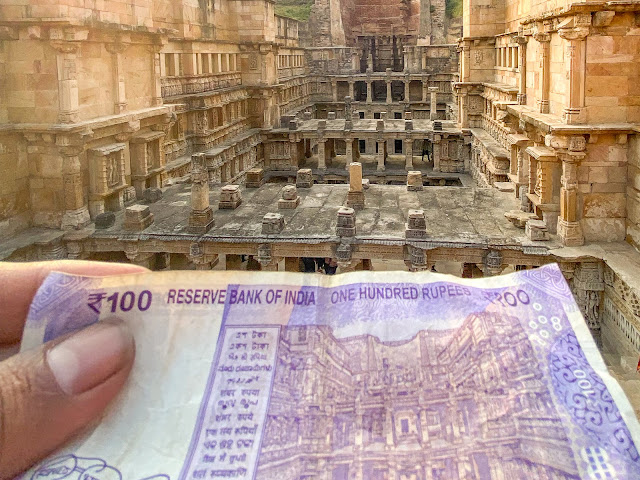 |
| Rani ki Vav on Rs 100 Indian Note |
How was Rani ki Vav constructed?
Rani ki Vav was constructed using the Maru-Gurjara style of architecture which was prevalent during the Chaulukya period. Maru Gurjara style of architecture consists of high plinths and highly decorated walls. The walls had carvings of figures of Gods and Goddess, rosetta ceilings and balconies open to all directions.
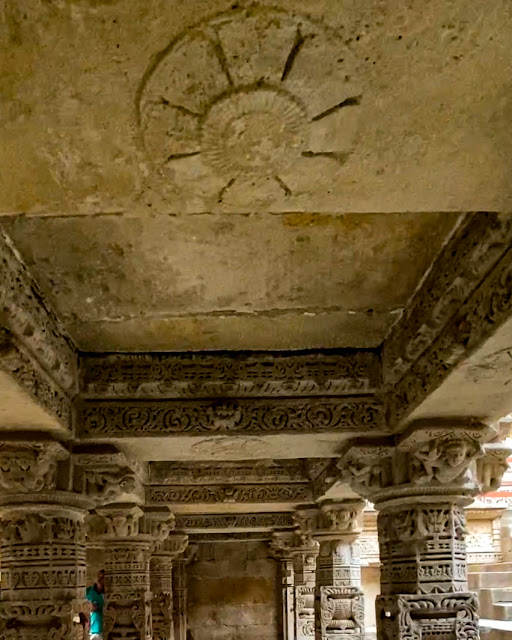 |
| Rossetta Cieling of Rani ki Vav |
The builders first dug trenches in the earth to go deeper to find the water and while doing so they constructed a staircase so that it becomes easier to reach the well. The walls of the trench were also built so that the structure don’t collapse from the sides. To make the structure strong the architects and builders also added buffer structure behind the walls of Rani ki Vav so that it can withstand the pressure of the earth. The wall which is visible from outside is extremely thick and is hidden inside the earth.
The builders also spilt up the walls to create terraces which were later converted into Pillar pavilions. This was done to provide further strength to the structure and also acted as a resting place and place where villagers will come and sit and chat for hours.
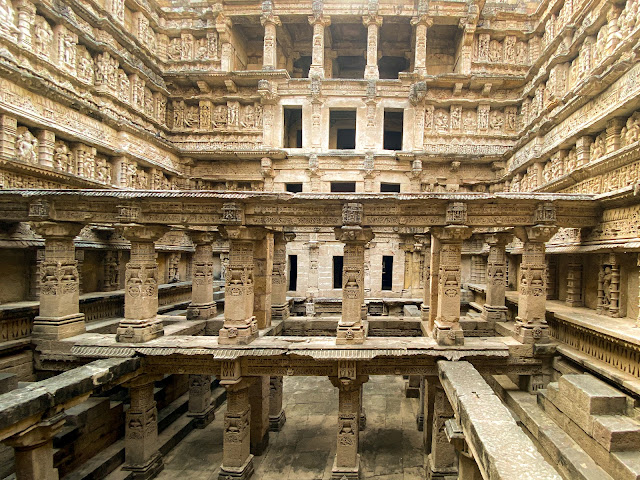 |
| Pillars of Rani ki Vav |
Also, multiple steps would be created and the main advantage of it is to create walls with smaller heights thus giving the structure more strength.
In a similar fashion, multiple layers and pillar pavilion was constructed for Rani ki Vav. There were 7 layers in Rani ki Vav however now only 5 layers exist.
Rani ki Vav architectural details
Rani ki Vav is spread over 12 acres of land and the Rani ki Vav is 64 meters long, 20 meters wide and 27 meters deep. The 4th layer is the deepest layer with space for storing water.
Rani ki Vav is designed like an inverted temple which the 7th Layer is the core of the temple. Gods are adorned on the wall of the Rani ki Vav which we will discuss in detail here later. There are four spacious pavilions, 500 Primary sculptures of Gods & 1000 secondary sculptures. Due to the presence of deities and water being worshipped earlier, it is believed to be also a temple.
The sidewalls of rani ki vav are ordained with multiple figures of Gods whose approximate size is 3 ¼ feet.
 |
| Inside portion of the Well of Rani ki Vav ( Source) |
Water entered through the opening of the Circular Well and depending on the season a particular layer will get filled up with water. During the rainy season and during floods water would fill up to Layer 3 or Layer 4 and during the dry and arid season water would recede to Layer 6 or 7 when people had to go all the way down to get water.
When you stand at the top of the Rani ki Vav( near layer 1) you will be able to see the layers clearly and the use of staircase at various places. However since it’s a huge structure they constructed small stairs or supplementary stairs which connected the 4th to the 7th floor, this was done so that the people don’t have to take the main staircase to navigate between the layers which can be time taking and tiresome as well. You will be able to see small pyramid-like stairs on every floor on Rani ki Vav which connects various floors. These small stairs not only helps to navigate the structure easily but looks beautiful when seen from far.
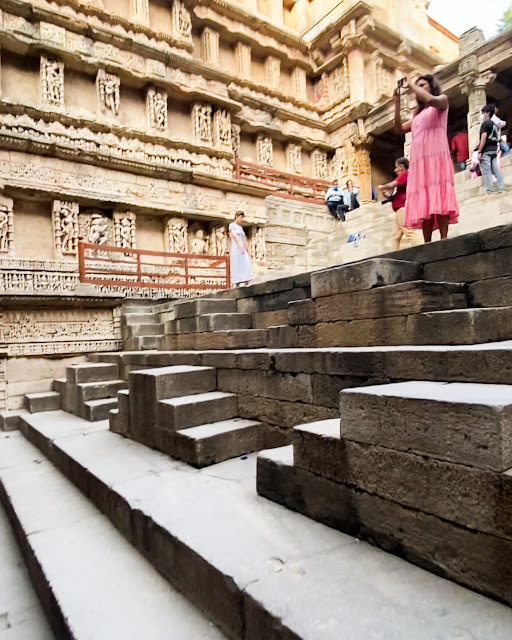 |
| Pyramid steps in Rani ki Vav |
 |
| Connecting steps of Rani ki Vav |
Initially, there were 292 pillars out of which only 226 are remaining. The First and second stages don’t have any pillars anymore due to damages, however when you reach Layer 3 and below of Rani ki Vav stepwell, you will be able to see the pillars decorated with deities and also apsaras. The pillars of Stage 3 and above are well protected from damage. The side panels of Rani ki Vav have deities whereas the pillars are ordained with Apsaras.
The Kund of Rani ki Vav stepwell is one of the largest you could see in any stepwell and is one of the prominent structures of Rani Ki vav. The Kund of Rani Ki Vav is approximately 7 meters in length, 6 meters in breadth and 3 meters deep. The Kund is connected with the well so that any excess water of the well can fill it up during the rainy season. It also helped to stop the flooding of the well and the structure overall and provided easy access to water for the locals during the rainy season. The kind also acted as a water reservoir to store water during the dry season.
 |
| Sculptures on the Well of Rani ki Vav |
We couldn’t see it, however, research and documents show that’s the slabs on the floors of the Kund area of Rani ki Vav shows various markings and numbers written on them to align the slabs. This clearly shows the care it has been taken to build the stepwell of Rani ki Vav.
Also if you look at the structure you will see horizontal, vertical or criss-cross marks which looks like chisel marks on the walls of the Rani Ki Vav stepwell. These are called Masonry marks which you can find in many historical structures. These marks are done by the masons to show which parts they have worked on so that they can get be paid accordingly.
 |
| Masonry Marks |
You will be able to see approx. two-story-high structure builds on top of the reservoir. This was done as an afterthought of building the Rani ki Vav stepwell as the builders felt that the depth of the reservoir can make the entire structure of the Rani ki Vav Stepwell weak, hence they added these pillars and frames.
The pillars are not different from what we find in other parts of the Rani ki Vav stepwell. The historians conclude that since the designs and the construction of the Pillars are similar hence it was constructed during the same time as building Rani ki Vav stepwell. Due to these additional pillars, you will not be able to see the well or the reservoir from any angle and hence the beauty of the reservoir nor the well cant be seen. The builders had designed a very ornate well and reservoir, however since these pillars were added later in Rani ki Vav the designs couldn’t be seen.
 |
| Rani ki Vav Top View |
The main part of Rani ki Vav is the well which can only be seen now from the other side of the stepwell. The well is approximately 28 meters in-depth and the diameter is 10 meters. The wall of the well is ordained with beautiful sculptures however due to the building of the pillars to reinforce the structures it is not visible from the fourth level. The well was fed by the river Saraswati from all sides and once the well got filled up, the water used to overflow to the Kind area.
The Beautiful Sculptures of Rani ki Vav Stepwell
As soon as you enter Rani ki Vav stepwell you will be able to see the walls full of sculptures of beautiful deities. The sculptures range from Balarama to Buddha showing the influence of many religions in the area during the 11th Century.
It is believed that Rani ki Vav has some 800 sculptures. Every terrace wall has 3 layers of sculptures. The Middle layer of Rani ki Vav is designed for deities and is larger in size compared to the bottom and top which has sculptures of smaller size. The Top and Bottom panels mainly depicted the apsaras.
 |
| Rani Ki Vav Sculptures on Wall |
The main sculptures are of Vishnu and Parvati. The main reason for portraying the God Vishnu is because the god is associated with water. You can find the sculpture of God Vishnu in his 10 avatars ( Dashavatara) and 24 forms.
You can also see the Goddess Parvati in many avatars in Rani ki Vav.
The main avatars of God Vishnu that you can clearly see are Varaha, Vamana, Rama, Balaram, Parsurama, Kalki & Buddha.
The first avatar of Vishnu which will strike your eyes as soon as you enter the 3rd stage of Rani ki Vav and can’t be missed is the avatar of Varaha or the Boar. God Vishnu is shown with the head of a boar where he is shown as the God lifting the earth goddess out of the ocean. Notice the intricate design on Conch which he is holding.
 |
| Varaha Avataar of Vishnu |
Vamana is the next avatar of Vishnu which you can see. Vamana in Sanskrit means dwarf and Vishnu took the form of Vamana to enter the courts of demon kings to reclaim the supremacy of the Gods. Check the mark on the chest of the sculpture which is called as Srivatsa mark, which means beloved of Sri i.e. Goddess Lakshmi. This mark is shown as an area on God Vishnu where Goddess Lakhsmi resides.
 |
| Vamana Avatar of Vishnu |
The next interesting sculpture in Rani ki Vav is of Lord Rama. We have always read that Lord Rama is like any other human being with just two hands, however, in this sculpture of Lord Rama in Rani ki Vav you will see Lord Rama with 4 hands. This is extremely interesting as hardly anywhere in India you will find an idol of Lord Rama with 4 hands.
 |
| Lord Rama with Four Hands |
Not many people know that in the Vaishnavite sect it is believed that Gautam Buddha is the reincarnation of God Vishnu. He is believed to be the 9th avatar of God Vishnu. In Rani ki Vav you can see Gautam Buddha depicted as an avatar of God Vishnu. It can be clearly said that the architects of Rani Ki Vav had a direct influence on the Vaishnavite sect. It is also believed that Buddhism had disappeared from the region of Gujarat a few centuries before Rani ki Vav was built hence no way the architects could have got inspired by Buddhism and hence the influence of the Vaishnavite sect on architects makes much more sense.
 |
| Vishnu's avatar Gautam Buddha |
Another striking sculpture that will strike your eyes is Mahisasurmardini where Goddess Parvati is being shown as killing the demon god Asura. Notice the details of the weapon which have been carved in the 10 hands of Goddess Parvati.
The well was also decorated with beautiful sculptures. One important aspect of the Rani ki Vav stepwell is you can see the sculpture of God Vishnu in a sleeping position on the serpent in the well. Three sculptures were built on top of each other so that at any level one of the sculptures of God Vishnu was visible.
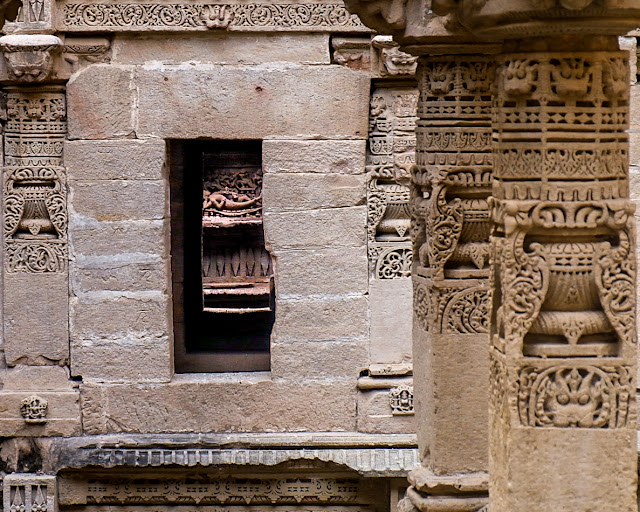 |
| Sleeping God Vishnu on a Serpent |
 |
| Parvati Avatar in Rani ki Vav |
Rani Ki Vav – UNESCO World Heritage Site in India
In 2014 Rani ki Vav was designated as a UNESCO world heritage site for fulfilling two main criteria. It got selected on the criteria of “to represent a masterpiece of human creative genius;” & “to be an outstanding example of a type of building, architectural or technological ensemble or landscape which illustrates (a) significant stage(s) in human history” which are Criterion 1 & 4 for selection of UNESCO world heritage site.
To commemorate this the picture of Rani ki Vav was printed on Rs 100 currency note and now has become a major tourist attraction in Gujarat.
How to Reach Rani Ki Vav?
Rani ki Vav is situated in Patan in Gujarat
The nearest airport is Ahmedabad Airport. From Ahmedabad, Rani ki Vav is approximately 127 kilometres. You can hire a car and travel to Rani ki Vav. Though you can do as a day trip and visit Rani ki Vav, I would suggest if you can stay there so that you will get ample time to enjoy the beautiful architecture of Rani ki Vav.
You can reach Rani ki Vav by train. You need to take a train which stops at Mehsana. From Mehasan you can hire a car and reach Rani ki Vav. The distance from Mehsana is approximately 55 kilometres and should take you around 1.5 hours to reach Rani Ki Vav.
How much time should I spend in Rani Ki Vav?
If you are interested in architecture and history then half a day or approximately 2-3 hours is enough to enjoy Rani ki Vav to the fullest. However, for a normal tourist 30-45 minutes is good enough for Rani ki Vav.
Entry Fee for Rani ki Vav
If you are an Indian/ SAARC & BIMSTEC then the entry fee for Rani Ki Vav is Rs 35, for a foreigner entry fee to Rani ki Vav it's Rs 550.
You can book online tickets for Rani Ki Vav at https://asi.payumoney.com/
What is the Best Time to Visit Rani ki Vav?
Rani ki Vav opens at 8am, so I would suggest you visit early morning as the place will not be empty but you can save yourself from the scorching sun. Going to Rani ki Vav in the morning also gives a good photo opportunity in terms of clear sky.
Interesting Facts about Rani ki Vav
Rani ki vav was awarded the Cleanest iconic place by Indian Sanitisation Conference in 2016.
Under the last step well of Rani Ki Vav, there is a gate that opens to a long tunnel and this tunnel leads to the town of Sidhpur in Patan. This tunnel was used as a secret passage to escape during the wars.
It is believed but not proven that water of the Rani ki Vav well can cure many diseases as in early days lots of medicinal plants were found nearby.
Rani ki Vav is the only Stepwell that is declared a UNESCO World Heritage Site.
This is one of the unique structures which was built by a Queen to commemorate the King. Most of the structures that we find are for queens.
Let me know if you want to know anything else about of Rani ki Vav or any particular information related to the history, architecture or sculpture of Rani ki Vav.
If you want to read it later then we have Pinterest Pin ready for you. So you can Pin the below image for reading later about Rani Ki Vav.



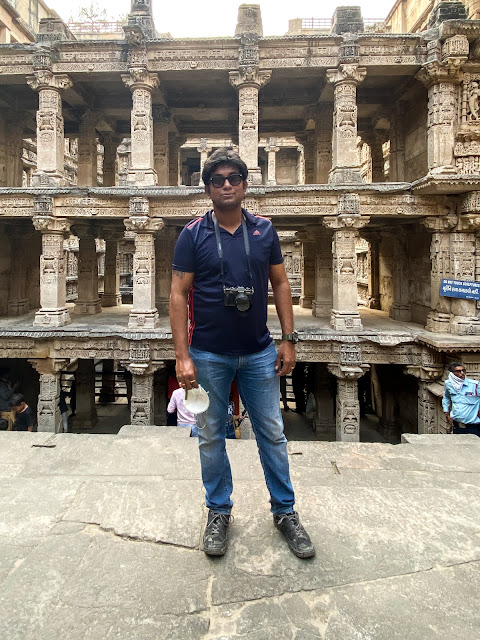
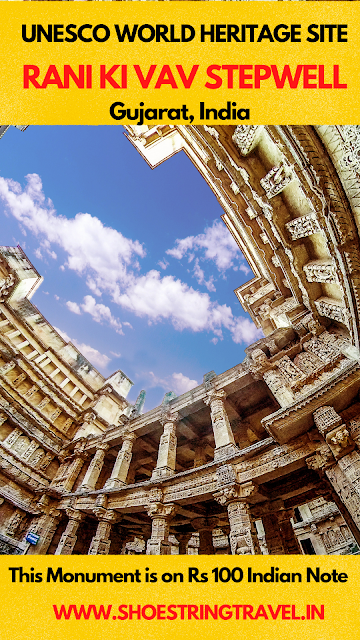









Good post man. Thanks for the detailed information.
ReplyDelete